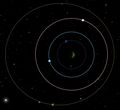Difference between revisions of "Jool/zh-cn"
m |
|||
| Line 3: | Line 3: | ||
'''Jool''' 是一颗[[w:Gas giant|气态巨行星]],是 [[Kerbol]] 星系中的第六颗行星。它实际上就是 Kerbal 太空计划中的[[w:Jupiter|木星]]。除 Kerbol 之外,在星系中所有天体中,Jool 的直径和质量都排名第一。虽然它距离 [[Kerbin]] 很远,难以到达,它还是由于其自身复杂的五卫星体系成为极具吸引力的航天探索目标,它的五颗卫星包括:'''[[Laythe]]'''、'''[[Vall]]'''、'''[[Tylo]]'''、'''[[Bop]]'''和'''[[Pol]]'''。 | '''Jool''' 是一颗[[w:Gas giant|气态巨行星]],是 [[Kerbol]] 星系中的第六颗行星。它实际上就是 Kerbal 太空计划中的[[w:Jupiter|木星]]。除 Kerbol 之外,在星系中所有天体中,Jool 的直径和质量都排名第一。虽然它距离 [[Kerbin]] 很远,难以到达,它还是由于其自身复杂的五卫星体系成为极具吸引力的航天探索目标,它的五颗卫星包括:'''[[Laythe]]'''、'''[[Vall]]'''、'''[[Tylo]]'''、'''[[Bop]]'''和'''[[Pol]]'''。 | ||
| − | == | + | == 大气层 == |
{| | {| | ||
| | | | ||
| − | [[File:JoolAtmosphere.png|thumb|right| | + | [[File:JoolAtmosphere.png|thumb|right|Jool 大气层中的空气制动。]] |
| − | + | 尽管 Jool 的半径是 Kerbin 的十倍,它的[[atmosphere|大气层]]高度只有 Kerbin 的两倍(138.2 km)。它异常稠密,非常适合进行高速星际转移任务的[[aerobraking|空气制动]]。其大气层外最低轨道的周期为 94.7437 分钟,速度为 6,785 m/s。进行空气制动飞行时,通常是没必要进入 100 km 轨道高度之下的。 | |
| − | + | 总之,Jool 的气压与高度(米)的关系为: | |
: <math>p_j = 15\ e^{-altitude/10000}</math> | : <math>p_j = 15\ e^{-altitude/10000}</math> | ||
| − | [[File:Kerbal_landing_on_jool.png|thumb|left| | + | [[File:Kerbal_landing_on_jool.png|thumb|left|Kerbal 航天员在 Jool “表面” 着陆的后果]] |
| − | + | 靠近行星表面时,游戏的物理模型会完全失效。由于其极其稠密的大气层,终点速度会降得很低,所以轻型飞船的降落根本不需要降落伞或反推火箭。Jool 的表面没有固态区域可供着陆,飞船最终的命运都是被 [[Kraken]] 吞噬。如果飞船很小,它或许可以从 Kraken 逃脱,但落至表面 100m 以下时,组件会爆炸。你会在任务概述中看到诸如“……与云相撞”之类的信息。 | |
| − | + | Kerbin 航天员可以通过 EVA 安全登陆 Jool,不过这只是一趟无法回头的单程旅行。你可以在[http://www.youtube.com/watch?v=Kkeb5-u3-lY 这个视频]的最后看到,小绿人会无法控制的抖动变形。不过这只会在 4x 的时间压缩下看到。游戏会退出,黑屏,高度表快速的变化显示数字。Kerbin 的大气层会消失,只有重启游戏才能让它恢复正常。 | |
| − | |} | + | |} 这个奇特的现象,通常都会在 Jool 上发生,不过倒不是只有在那儿,其实在 Kerbin 的某些极端情况下也会出现;例如,从高速飞行起飞的太空飞机上进行 EVA 有时也会出现这一奇景。如果在 Jool 之外遇到这个现象,其实是很难复制的,所以很少能看到这类视频。 |
== 时间加速 == | == 时间加速 == | ||
Revision as of 09:06, 19 June 2013
Jool 是一颗气态巨行星,是 Kerbol 星系中的第六颗行星。它实际上就是 Kerbal 太空计划中的木星。除 Kerbol 之外,在星系中所有天体中,Jool 的直径和质量都排名第一。虽然它距离 Kerbin 很远,难以到达,它还是由于其自身复杂的五卫星体系成为极具吸引力的航天探索目标,它的五颗卫星包括:Laythe、Vall、Tylo、Bop和Pol。
大气层
|
尽管 Jool 的半径是 Kerbin 的十倍,它的大气层高度只有 Kerbin 的两倍(138.2 km)。它异常稠密,非常适合进行高速星际转移任务的空气制动。其大气层外最低轨道的周期为 94.7437 分钟,速度为 6,785 m/s。进行空气制动飞行时,通常是没必要进入 100 km 轨道高度之下的。 总之,Jool 的气压与高度(米)的关系为: 靠近行星表面时,游戏的物理模型会完全失效。由于其极其稠密的大气层,终点速度会降得很低,所以轻型飞船的降落根本不需要降落伞或反推火箭。Jool 的表面没有固态区域可供着陆,飞船最终的命运都是被 Kraken 吞噬。如果飞船很小,它或许可以从 Kraken 逃脱,但落至表面 100m 以下时,组件会爆炸。你会在任务概述中看到诸如“……与云相撞”之类的信息。 Kerbin 航天员可以通过 EVA 安全登陆 Jool,不过这只是一趟无法回头的单程旅行。你可以在这个视频的最后看到,小绿人会无法控制的抖动变形。不过这只会在 4x 的时间压缩下看到。游戏会退出,黑屏,高度表快速的变化显示数字。Kerbin 的大气层会消失,只有重启游戏才能让它恢复正常。 |
时间加速
| 时间加速 | 最低海拔 |
|---|---|
| 1× | 所有 |
| 5× | 200 000 米 (高于大气上限) |
| 10× | 200 000 米 (高于大气上限) |
| 50× | 200 000 米 (高于大气上限) |
| 100× | 200 000 米 (高于大气上限) |
| 1 000× | 300 000 米 |
| 10 000× | 600 000 米 |
| 100 000× | 1 200 000 米 |
天然卫星
 大片海洋覆盖的月亮,Laythe,我们即将观察到它的凌 Jool 现象。 Jool 有五颗天然卫星,每个卫星的轨道平面都和 Jool 自身的轨道平面相重合:
Laythe、Vall 和 Tylo 三者的轨道符合拉普拉斯共振,轨道周期比为 1:2:4 。尽管理论上说在这种状态下,各卫星与 Jool 彼此易出现“蚀”现象,现实是没有,它们在轨道上运行的秋毫无犯。 Jool 卫星的同步轨道是不存在的,因为理论的轨道已经处于各个卫星的引力作用球体范围之外,这是同步自传天体常见的现象。 |
图集
- Screenshot540.png
Jool 的低轨运行。
- Screenshot73.png
带有控制小翼的探测器。Note that as you descend deeper into the atmosphere, it gets harder to move at all, rendering RCS and winglets useless.
- Screenshote4141412.png
A view of Laythe, Vall, and Tylo during an aerobraking on Jool.
Trivia
- Jool has roughly the same equatorial radius as the planets Earth and Venus.
- The sunsets and sunrises on Jool are a shade of yellowish brown.
- Like Jool, Jupiter's nearest three moons (Io, Europa, and Ganymede) have a Laplace resonance of 1:2:4.
Changes
- Added a new, more distant moon named Pol.
- Initial Release







